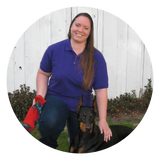What is Your Dog Saying?

We hear it all of the time in Scent Work, “learn how to read your dog.” Understand what they are communicating as they work through a search area and space. When do they get a whiff of the odor? How do they announce they are chasing odor or are going in and out of an odor plume? What are the cues they share when they are assessing odor information or something else entirely? How do we know when they are sourcing a hide? How do they let us know they have made a final decision?
Grasping how our individual dog communicates their experience with odor is indeed critically important when searching with our dogs.
However, it is folly to only focus on the odor side of this communication. What about everything else? Wouldn’t these pieces of communication be equally, if not more, important for us to listen to and understand? As far as I am concerned, they are imperative for us to succeed and is an area far too many of us are lacking in.
Before embarking on any sort of behavior work, be it as a dog owner or baby trainer, the first piece of business is to better understand canine communication. How dogs use their bodies to communicate with one another and us. Learning how to correctly interpret the dog’s cues is key. Is the dog requesting space or inviting a greeting? Is the dog excited, inquisitive, puzzled or concerned? Is the dog in their “thinking” brain or have they flipped over into their “reactive” brain?
It may not seem obvious, but this knowledge is equally important when it comes to participating in Scent Work.
Can you tell, for certain, when your dog is asking for assistance due to being confused as opposed to being overwhelmed? You should, these are entirely different scenarios which necessitate unique responses from us. Keeping an overwhelmed dog in a space to “sort it out” will not serve you well. Likewise, cutting off a dog who was merely asking a question to rush them back into their staging area can deny them a key learning opportunity and cause more confusion.
We must be able to correctly decipher what our dogs are telling us so we can respond appropriately!
Are you confident you can tell when your dog is urging you to do the puzzle for them as opposed to balking because they are scared, concerned or worried? If we are training and practicing with our dogs, the answer should be a resounding “YES!” However, all too often people are unsure.
Let’s say you are working on building your dog’s confidence. A favorite exercise of mine utilizes a pile of boxes. An odor box is placed on the ground with a bunch of open empty boxes piled on top of it. Can the dog confidently work their way through the pile to get to the odor box or do they show me this is something we need to work on?
Let’s say a dog hesitated getting to the odor box. What does this mean? It all depends on HOW the dog hesitated and what they were communicating when they did so.
A dog who circles around the pile, stretching while keeping the majority of their weight back on their hind end and jolting anytime a box moves is concerned. Are they panicked? No. They are still actively trying. However, there is a level of concern there. It is our job to recognize this concern and determine how close to this dog’s “edge of the ledge” we are.
Our goal is to push the boundaries, dancing right up to this edge without forcing the dog to tumble off of it. Thus we have two choices: wait the dog out to see if they can indeed solve the puzzle on their own or quit while they are still trying. If we chose the latter, we would say “NICE TRY!” with a kind tone of voice, put the dog up for a few minutes and adjust the exercise slightly so they CAN be successful. The goal being to work back to the original setup and even surpass it, understanding this may take time and several repetitions.
Now let’s say we have a dog who circles the pile of boxes, sniffs it a few times, is not stretching or jolting but promptly looks back up at their handler. This dog is not working their way to the odor box in any way, shape or form. Are they concerned? It doesn’t sound like it. The communication cues are more along the lines of, “Hey you with the thumbs, go get that hide for me, it is over there.” We can all agree this is NOT what we are looking for in our searches. What can we do?
One option is to pretend to do what the dog wants. Pick up a nearby empty box, step toward the pile as though you are about to solve the puzzle for them. However, instead of doing their bidding, place the empty box on top of the pile. The dog will likely look at you with disappointment. That was not helping! You made the puzzle harder, boo! Now, in reality you can be sneaky and use this opportunity to make the pathway to the covered box wider or easier to traverse. But to your dog, you were useless! You’ve made it clear that asking you to do the puzzle for them will not work, they must do it on their own. Which just so happens to be precisely what we were looking for in the first place.
Can we all agree these two dogs who both hesitated to solve the same exact odor puzzle were saying drastically different things and thus required unique responses from us as trainers?
If we cannot truly grasp what our dogs are telling us, how can we hope to be the supportive teammate they deserve? We could respond in a way that undercuts them entirely, setting their progress and trust in us backwards.
Striving to develop uberconfident dogs who will stride into any space and tackle a search with tenacity and resiliency is a good goal to have. However, our dog’s experience while we train to obtain these goals matters. “Just train for it” or “stop babying your dog” doesn’t account for the fact there are times we mess up as trainers.
We design an exercise our dog simply cannot do. It could be that they are physically unable or lacked the requisite skills. Perhaps the environment was too challenging, we stacked far too many stressors on top of one another or we placed too much pressure on them. Maybe we did not fully grasp what the intent of the exercise was, so there was confusion on both ends of the leash. Perhaps they simply do not feel well and drilling something to death is not going to help! It is our duty to listen to our learner, to get feedback from them and make adjustments from there.
When our dogs are saying, “Hey, I’m struggling,” we must listen, truly grasp what their communication means and react accordingly.
To help, here is a short exercise for you. Think through the following scenarios and describe what you believe the dog is communicating and how you would react. Write your guesses in the comments.
You approach a start line for a container search with your dog. After giving them 5 seconds to focus on the space, you give your search cue. The dog takes a step, does a full body shake and turns toward their flank before slowly entering the space with their head skimming just above the ground.
Your dog is tackling an exterior search and has successfully found 2 of the 4 hides set in the space. As they are striding along, they suddenly spin, halt and plaster their nose to the ground, locking their front elbows and swinging their hind end.
During an interior search, your dog is in the process of sniffing the outer edges of a chair when a door slams shut in the distance. Your dog’s head shoots up, their mouth closed, ears and tail erect. The seconds tick by as your dog continues to stare off in the direction of the noise. Even as you try to apply some leash pressure, they brace themselves, maintaining their stare and stance.
Your dog is working a vehicle search set out in a parking lot during a hot summer day. They perform a lovely wrap around the vehicle, mouth closed while closely investigating the outside of the vehicle. When they reach the wheel well they pause and do more concentrated sniffing before opening their mouth, panting heavily and heading toward some shade.
For each of these scenarios, consider how you may follow up. What would you adjust or do differently in a subsequent exercise? What information has the dog provided and how will this inform the decisions you may make going forward? Does this require more drilling of a certain skill or exercise or something else entirely? Does the solution exist in or outside the realm of Scent Work?
Yes, we must be capable of reading our dogs as they work odor. However we are hindering ourselves by not striving to hear everything our dogs are telling us.
Looking for resources to learn? Check out the following webinars:
- Learn to Speak Dog: Vol I Webinar
- Learn to Speak Dog: Vol II Webinar
- Canine Body Behavior and Scent Work for Dog Owners Webinar
- Canine Body Behavior and Scent Work for Instructors Webinar
-
Canine Body Behavior and Scent Work for Trial Officials Webinar
- Displacement Sniffing and Other Stress Behaviors Webinar with Sue Sternberg

Dianna has been training dogs professionally since 2011. She has done everything from teaching group training classes and private lessons, to specializing in working with fearful, reactive and aggressive dogs, to being a trial official and competition organization staff member.
Following a serious neck and back injury, Dianna was forced to retire from in-person dog training. But she was not ready to give up her passion! So, she created Pet Dog U and Scent Work University to provide outstanding online dog training to as many dog handlers, owners and trainers possible…regardless of where they live! Dianna is incredibly grateful to the amazingly talented group of instructors who have joined PDU and SWU and she looks forward to the continued growth of PDU and SWU and increased learning opportunities all of these online dog training platforms can provide.
In June 2021, Dianna and her business partner, Sean McMurray launched Cyber Scent Work, an organization that operates in the gray space between training and trialing in Scent Work. With Cyber Scent Work, handlers have the opportunity to earn Qs, titles and ribbons while also receiving helpful training advice regardless of whether they qualify or not! The advent of the Cyber Sniffing Games, Traditional Cyber Scent Work Program, in-person and online assessments have been met with much fanfare! Be sure to check out Cyber Scent Work, you will be happy you did!
Join Our Newsletter
Stay up to date with all the happenings at Scent Work University, including the release of new online courses, seminars, webinars, eBooks and receive exclusive promotions and discounts!


